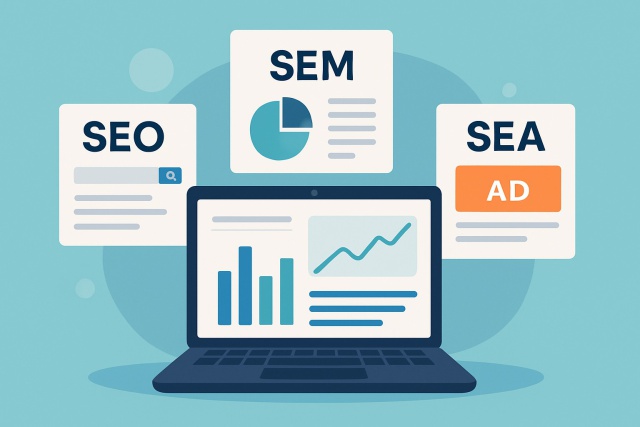
SEM vs SEO vs SEA
Confused by SEM, SEO, and SEA? This clear guide breaks down each concept, showing how they work toge...
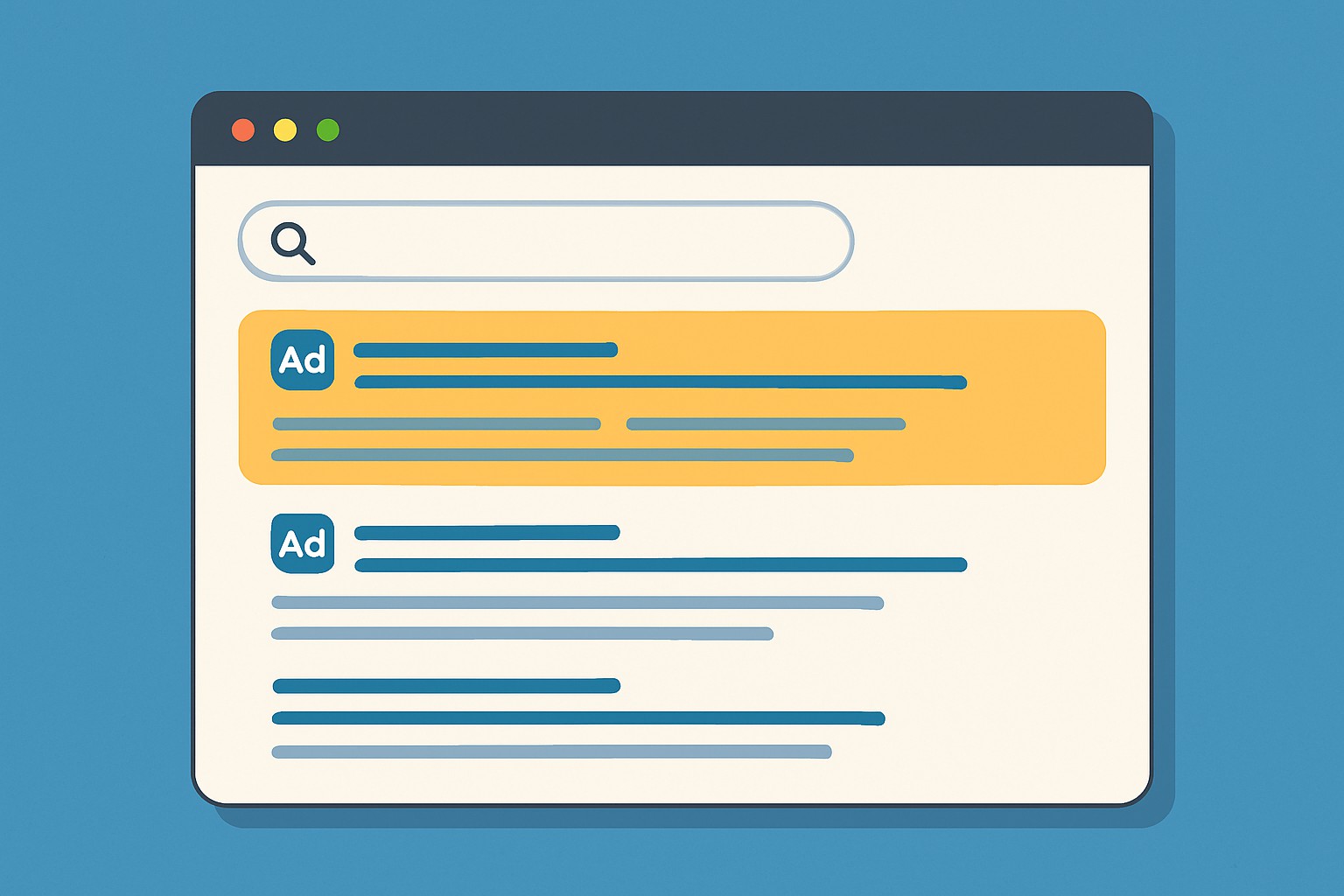
It is pretty common for people dipping their toes into digital marketing to confuse SEM and PPC, often tossing the terms around like they’re interchangeable without realizing there’s a clear-cut difference. Understanding the sem and ppc difference is actually key if you want to craft search advertising strategies that truly stretch your budget and resources. This article breaks down these buzzwords into plain, easy-to-grasp language to clear up any lingering confusion.
Search Engine Marketing or SEM if you like keeping things short covers a toolbox of strategies designed to give your business serious visibility on search engine results pages (SERPs). It’s not just about throwing money at ads—paid ads are part of the recipe—but it also includes the organic side like good old SEO. While individuals often think SEM means paid ads only, it actually refers to all the clever ways you can reel searchers in from fine-tuning your content to launching targeted ad campaigns.
Pay-Per-Click (PPC) is a type of digital advertising where advertisers shell out cash each time someone actually clicks on their ads. It is the bread and butter of paid methods in SEM, showing up most commonly on platforms like Google Ads and Bing Ads. PPC zeroes in on paid ads billed per click and usually offers surprisingly precise ways to connect with very specific audiences.
The main difference is that PPC focuses on a specific kind of paid advertising within the larger SEM umbrella. SEM, on the other hand, covers both paid tactics like PPC ads and organic routes such as SEO.
| Feature | SEM | PPC |
|---|---|---|
| Definition | All the tricks and tactics aimed at boosting your search visibility | Paid ads where you shell out cash only when someone actually clicks |
| Scope | Encompasses SEO, PPC, keyword research, and analytics — basically the whole search marketing toolbox | Zeroes in solely on paid search ads, no detours here |
| Cost Model | Can be all over the map; ranges from free SEO efforts to paid advertising | You pay strictly when someone clicks on your ad, no hidden fees |
| Organic Involvement | Yes, it’s about SEO and fine-tuning content to climb the ranks naturally | Nope, this one’s 100% pay-to-play, all about the ads |
| Platforms Used | Google, Bing, plus an army of SEO tools to keep things running smoothly | Google Ads, Bing Ads, and social PPC platforms ready to serve |
| Primary Goal | Building long-term visibility and steady traffic, playing the patience game | Getting immediate traffic and conversions by paying for those clicks, fast and focused |
This table lays out the key focus areas along with where SEM and PPC cross paths. Sorting out these differences can really give your campaign planning a leg up.
These myths often trip up marketers and steer them toward budgeting or strategy choices that don’t hit the mark. SEM includes SEO so it’s broader than just paid ads. PPC can run up a hefty bill if you’re not careful but with smart bidding strategies in place it’s manageable.
Bringing PPC campaigns into a broader SEM strategy lets businesses connect with audiences from multiple angles. Paid ads deliver quick visibility and provide a handy way to test different keywords. Organic SEO plays the patient role by building long-term rankings over time.
Dig deep into keyword research to uncover those hidden gems with the most bang for your buck.
Sprinkle these keywords into your PPC campaigns to not only draw traffic fast but also get a real feel for how your message lands.
Pay close attention to PPC data—think conversion rates and click-through rates—as these nuggets will help sharpen your SEO content.
Keep a steady eye on performance metrics across both paid and organic channels so you get the full picture, no blind spots.
Tweak your budget and priorities along the way, striking just the right balance between PPC spend and SEO efforts based on what your goals and results are telling you.
Deciding whether to dive into SEM as a whole or just stick with PPC really boils down to your business goals and budget. Timeline also plays a part. If you are after quick bursts of traffic that give an almost instant jolt, PPC campaigns often steal the spotlight. On the other hand, if steady organic growth and lasting brand visibility are more your style, a full SEM approach that marries SEO and PPC usually makes the most sense.
Getting the most out of your PPC and SEM campaigns definitely takes some careful attention and a few smart tweaks here and there. It really pays off to fine-tune your keyword targeting so you’re zeroed in on the right audience, and crafting ad copy that actually speaks to people and nudges them to click. Keeping a close eye on your Quality Score is a smart move for cutting costs and snagging those prime ad spots. Throwing in negative keywords is a clever way to dodge irrelevant traffic that just wastes your budget.
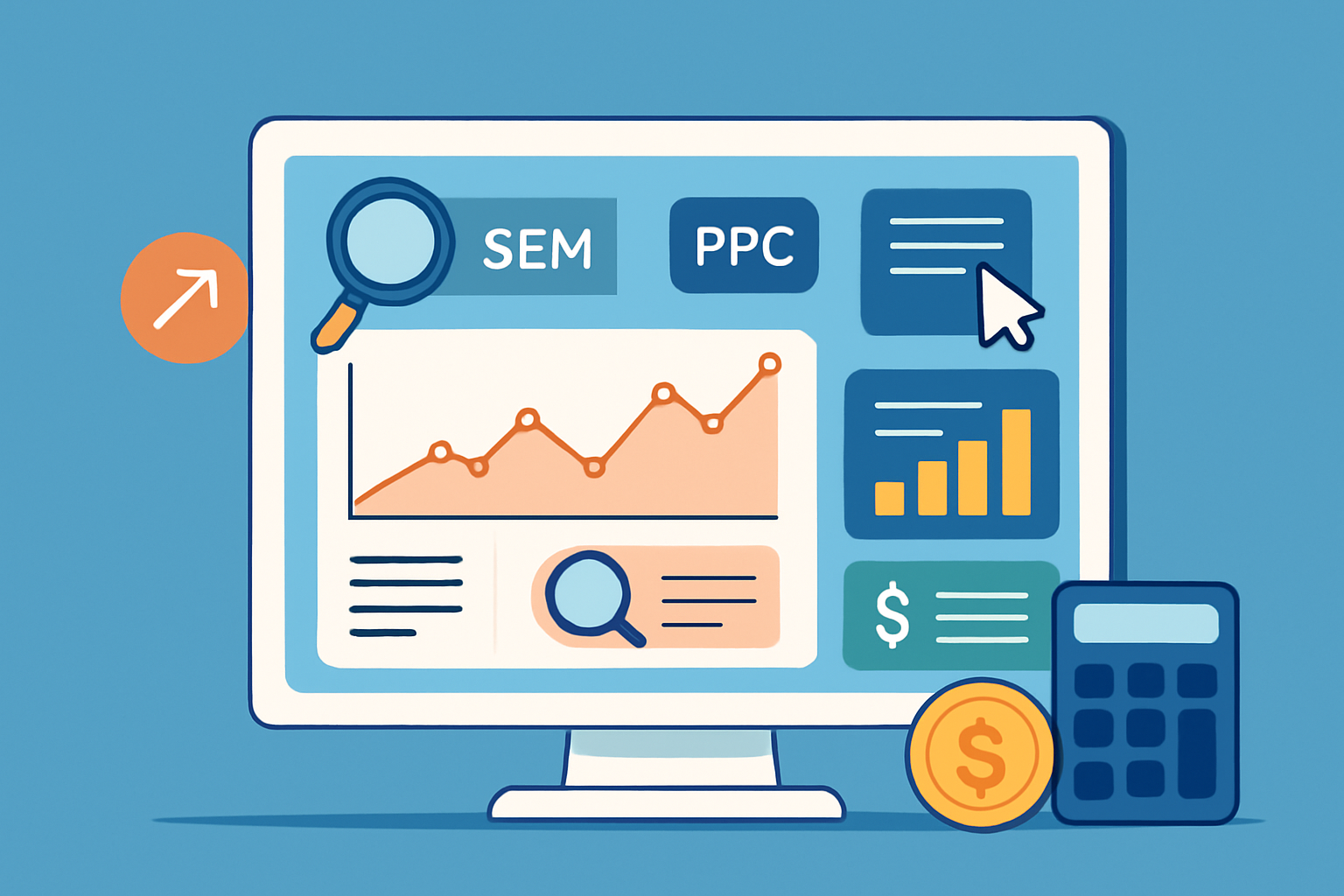
A digital marketing dashboard showing key SEM and PPC performance metrics including traffic, conversions, and cost efficiency.
When it comes to SEM and PPC, keeping an eye on key metrics isn’t just a good idea—it’s absolutely essential. After all, you can’t improve what you don’t measure, right? So whether you are a seasoned pro or just dipping your toes into the digital ad waters, understanding these metrics can really make all the difference between throwing money into a black hole or seeing a solid return. Let’s break down the numbers that really count and see how they can steer your campaigns in the right direction.
To get a feel for how well your SEM and PPC efforts are paying off it’s wise to keep a close watch on some key performance indicators or KPIs. When it comes to SEM you’ll want to focus on things like organic traffic, keyword rankings and conversion rates. These reveal the lasting impact of blending SEO with paid strategies. On the flip side, PPC metrics usually zoom in on quicker signals like cost per click, click-through rate and quality score.
| Metric Name | Definition | Relevance to SEM | Relevance to PPC | How to Use for Optimization |
|---|---|---|---|---|
| Organic Traffic | The count of visitors coming from unpaid search results | High - a key measure of SEO performance | Low - PPC doesn’t play a role here | Keep a close eye on growth over time to get a real feel for how your SEO efforts are paying off |
| Keyword Ranking | The position of your webpages in search results for targeted keywords | High - a fundamental SEO metric | Medium - can subtly impact ad placement | Work on boosting rankings along with your PPC moves to win on both fronts |
| Click-Through Rate (CTR) | The percentage of users who click on ads or organic links | Medium - a solid indicator of overall engagement | High - absolutely vital for PPC ad success | Fine-tune your ad copy and meta descriptions by digging into CTR data—it’s like getting a sneak peek at what’s clicking with your audience |
| Cost Per Click (CPC) | The average cost incurred for each ad click | Low - SEM is mostly about unpaid traffic | High - a vital stat for managing PPC budgets | Tweak your bids and polish up your ad quality to keep CPCs as low as a well-timed coupon |
| Quality Score | Google's rating of ad relevance and user experience | Not applicable | High - a strong factor affecting ad rank and cost | Zero in on making your ads more relevant and sprucing up your landing pages—you’d be surprised how much this helps |
| Conversion Rate | The share of visitors who complete the desired action | High - the ultimate goal for SEM | High - a key benchmark for PPC success | Use this golden nugget of info to refine your keywords, adjust bids, and give your page design some thoughtful tweaks |
Understanding the SEM and PPC difference along with these key metrics can set you up to make smarter, data-driven choices that keep your search marketing campaigns moving in the right direction.
18 articles published
Transforming the field of Internet Marketing, Orion Chadwick weaves a tapestry of creativity, data-driven insights, and user psychology, captivating audiences with his visionary perspectives.
Read Pages
Confused by SEM, SEO, and SEA? This clear guide breaks down each concept, showing how they work toge...
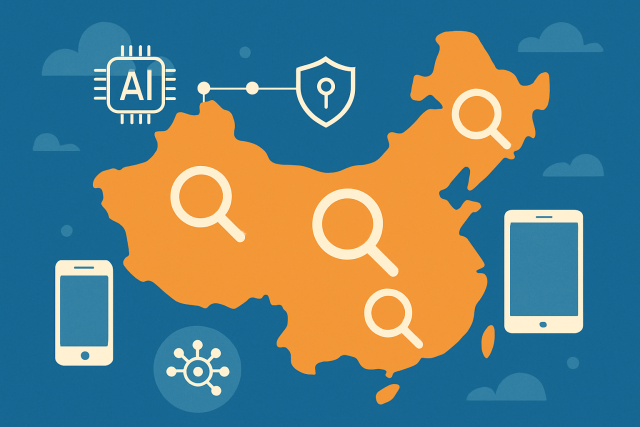
Dive into China's top web search engines like Baidu, Sogou, and Shenma, learning how they tailor sea...
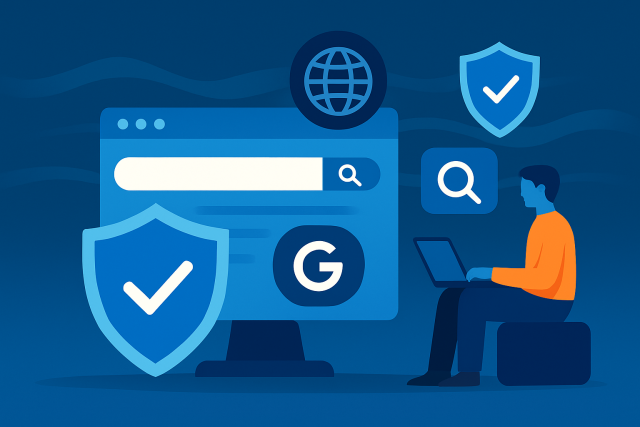
Concerned about privacy and data tracking? Discover top Google alternatives that offer strong privac...

Looking for LinkedIn alternatives tailored to your industry? Explore specialized platforms designed...